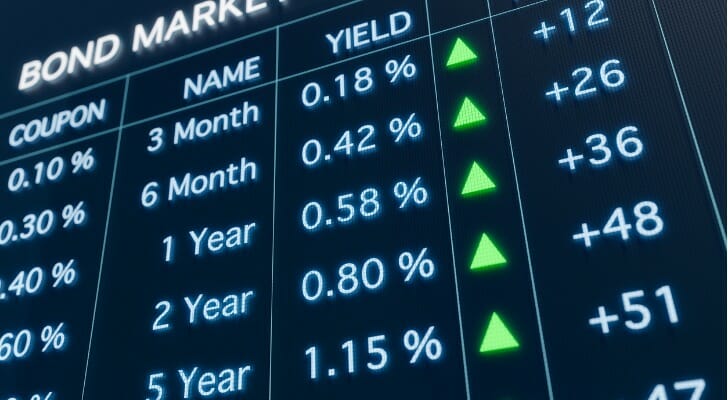 Investors who buy and sell stocks and options usually know how much they pay their broker per trade, but many people don’t know that bond trades also carry broker fees. Commonly called “markups,” these bond commissions are often baked into the quoted bond prices and can substantially affect your yield-to-maturity depending on the amount. In fact, regulators require brokers to disclose their markups only on certain bonds–and only after the transaction is done.
Investors who buy and sell stocks and options usually know how much they pay their broker per trade, but many people don’t know that bond trades also carry broker fees. Commonly called “markups,” these bond commissions are often baked into the quoted bond prices and can substantially affect your yield-to-maturity depending on the amount. In fact, regulators require brokers to disclose their markups only on certain bonds–and only after the transaction is done.
Although it can be difficult to determine how much commission you’re paying on your bond trades, there are a couple methods to figure out the true cost and yield of your bond. Here’s how.
A financial advisor could help you rebalance your portfolio and select lower-risk investments that align with your financial goals. Find a qualified advisor today.
Fidelity Says All Bonds Are Not Priced Equally
Bond trades, just like stock trades, carry a broker fee. Unlike with stocks, though, brokers often do not reveal these fees until after your purchase has been completed. As such, many bond investors may have no idea that they are paying a commission in addition to the price of the bond.
The bond market is highly opaque, with only a small fraction of the 1.2 million available bonds traded on public exchanges. Most bonds are traded “over the counter,” between brokerage firms and firms and their clients. Much of the pricing action goes on behind the scenes, and at the end, potential investors see a bond’s yield and quoted price.
Investment firm Fidelity Investments likens the process to buying wholesale and retail. Most bonds are bought and sold at “wholesale” prices, while investors see the “retail” pricing when they go to shop.
However, the firm cautions that not all bonds are priced equally. Bond markups theoretically help brokers cover buying and selling expenses, as well as costs related to custody and recordkeeping, but there is no rule that limits how much brokers can charge. These commissions can and do contribute to broker profits.
What Bond Investors Need to Know

Bond markups can vary widely between brokers, and this added cost has the potential to significantly impact an investor’s portfolio. The more you pay for a bond, after all, the lower the actual yield on your investment.
For example, if you buy a single $1,000 bond with a 3% coupon maturing June 1, 2032, priced at its par value of $100, a $15 per bond markup means your actual yield-to-maturity falls to 2.83%. Fidelity research calculates that buying an average purchase size of 22 bonds and paying $15 per bond in commission will result in over $300 in expenses alone.
It’s important, therefore, to ascertain how much a potential bond purchase will truly cost you. First, you can ask your broker how much it charges as a bond markup. Given the costs associated with bond trading, there is almost never no commission charged on bond sales.
Another good way to verify bond commissions is to comparison-shop. Although not all brokerage firms offer the same bonds, if you have accounts with different brokers, you can potentially check what prices each broker offers for the same bond and the difference between the two is often the difference in markup.
Lastly, you can review historical trade reporting data from the Municipal Securities Rulemaking Board (MSRB) and Trade Reporting and Compliance Engine (TRACE). While bond prices and yields change from day to day, you can also use this data to compare customer prices with dealer-to-dealer prices for trades executed at the same time.
Bottom Line

The bond market is still rather opaque, and many investors may not realize that they are paying commissions for every bond trade. Markups can vary widely depending on the broker, and these brokers are not required to disclose their commission until after the transaction has been done. However, markups can significantly reduce a bond’s real yield-to-maturity, which means that a bond’s yield could actually be lower than it appears. As such, it’s important to research beforehand how much an investor may be paying to conduct a bond trade.
Wealth-Building Tips
- Not sure what asset allocation mix and strategies will help you meet your long-term goals? For a solid financial plan, consider speaking with a qualified financial advisor. SmartAsset’s free tool matches you with up to three financial advisors who serve your area, and you can interview your advisor matches at no cost to decide which one is right for you. If you’re ready to find an advisor who can help you achieve your financial goals, get started now.
- Use SmartAsset’s free investment calculator to get a good estimate of how to grow your money over time.
Don’t miss out on news that could impact your finances. Get news and tips to make smarter financial decisions with SmartAsset’s semi-weekly email. It’s 100% free and you can unsubscribe at any time. Sign up today.
For important disclosures regarding SmartAsset, please click here.
Photo credit: ©iStock.com/Andrii Yalanskyi, ©iStock.com/Torsten Asmus, ©iStock.com/Kriangsak Koopattanakij